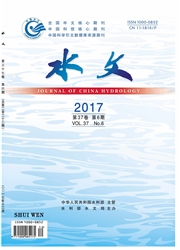

 中文摘要:
中文摘要:
研究结论有助于了解南京地区的水汽输送以及水汽循环过程。在全球大气降水同位素观测网(GNIP)南京站点的大气降水氢氧同位素资料基础上,并结合相关气象资料,分析了南京地区大气降水稳定同位素时间分布特征及其影响因素.并建立了局地大气降水线方程。结果表明:南京地区大气降水中春季最为富集、夏季最为贫化;年尺度下降水与温度之间不存在正相关,而与降水量之间存在负相关;季节尺度下,冬季的与温度、降水量的关系与年尺度结果相反,皆呈现出正相关关系。采用HYSPUT模型对站点水汽来源进行追踪,并结合季风活动分析得出:全年中南京大气降水变化主要受亚洲夏、冬季风及其带来的水汽影响,在季风交替时节(春、秋季)虽降水源于局地蒸发水汽,但仍为季风带来降水的影响。
 英文摘要:
英文摘要:
This study can help know water vapor transports and moisture cycle of Nanjing area. Based on the data of the hydrogen and oxygen stable isotopes in precipitation in Nanjing provide by the Global Network of Isotopes in Precipitation (GNIP) and the meteorological statistics, the temporal variations of stable isotopes in precipitation and their influencing factors were analyzed and the Local Meteoric Water Line (LMW L) was established. The results were as follows: value was high in spring and low in summer. As to the annual scale, the relationship between in precipitation and temperature was not positive correlated, was negative related to precipitation amount. To the seasonal scale, positive correlationship was found for temperature and precipita tion amount only in winter. The water vapor source of Nanjing was tracked by HYSPLIT model, the modeled trajectory of vapor source indicated that the variation of stable isotopes was influenced by Asian summer, winter monsoon and its vapor.
 同期刊论文项目
同期刊论文项目
 同项目期刊论文
同项目期刊论文
 期刊信息
期刊信息
